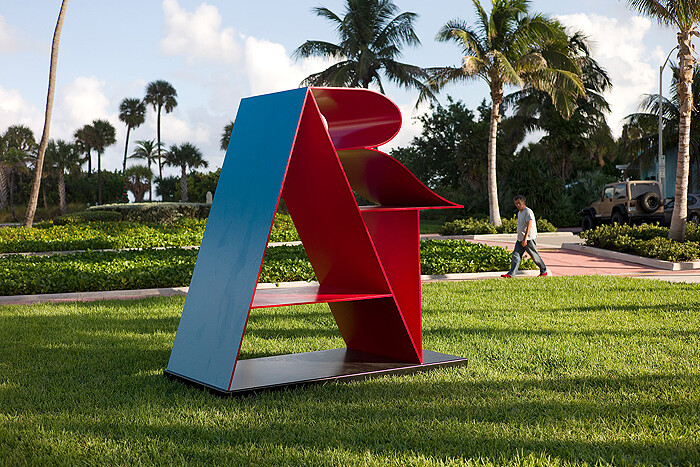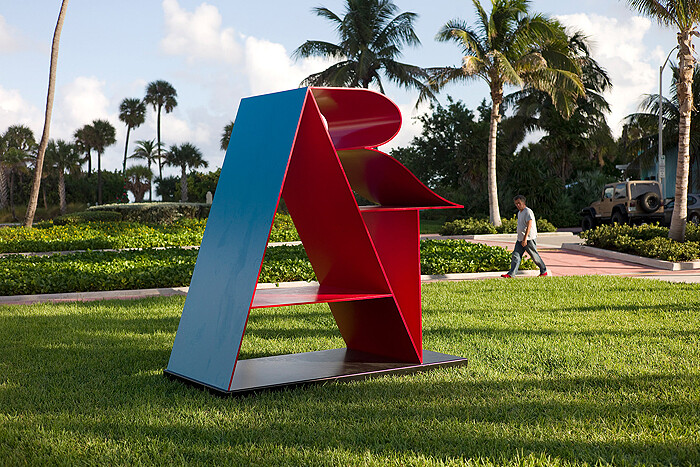In the tenth year of Art Basel Miami Beach, the number and range of supplementary events has skyrocketed. From satellite fairs, such as the more established NADA and Pulse or the newer Seven, to well-known private collections, quirky pop-up exhibitions, and endless performances, the peripheries of the fair have become a study in contrasts, or, as Jonathan T. D. Neil smartly observed in his review of the main fair, of cognitive dissonance. Despite the tenuous political climate, of occupations happening throughout the US and, in particular, New York, very little of this energy seemed to make its way to Miami Beach. The only hint of any sort of such resistance existed as a storefront exhibition, not-so-cleverly titled “Occupy Art Basel,” located a stone’s throw from the Miami Beach Convention Center. Ironically, it seemed to be constantly closed for business—so much for the 99%. I had a strange feeling that those who just a week ago could be found heading down to Zuccotti Park in lower Manhattan were now pool-side at the chic Raleigh Hotel, eating free hors d’oeuvres and drinking fancy champagne, rubbing shoulders with those they had just rallied against. The culture of spectacle and conspicuous consumption clearly still has the upper hand here, and, truth be told, everyone has the right to kick back periodically and forget their problems. It was this contrast though, between the poor attempting to look rich and the rich even more pitifully attempting to look poor, between the most subtle and the most spectacular, which truly defined the wide breadth of elements occurring outside the white walls of the convention centers, banquet halls, ballrooms, and hotel lobbies.
Emerging from the din of the buying and selling at the vernissage of Art Basel Miami Beach was a performative work by Theaster Gates (Kavi Gupta Gallery) and the Black Monks of Mississippi. Surprisingly, people actually seemed to stop what they were doing and quietly watch. The ritualistic dancing and soulful spiritual singing of the performers was as mesmerizing as it was confusing within the context of the six-figure deals being made all around. As the performers slowly walked through the fair and out the exit, they continued to sing, modifying their songs to address each of the public sculptures installed in nearby Collins Park.
These works, despite the well-crafted curatorial statement by Christine Y. Kim, unfortunately felt more like extensions of the commercial fair rather than the investigations of sculptural practice they claimed to be. Kim’s line-up, noticeably rife with superstar artists from galleries who could afford both to be inside the fair and also ship down heavy and expensive pieces for Art Public, accounted for what felt like a missed opportunity to legitimately engage with the park and its shifting landscape from the Bass Museum to the Atlantic Ocean.
Only a few hours later, around the pool of the Delano Hotel, was a performance by the hot art world band, S4lem. With a heavy cloud of steam rising off the pool the band droned on as two exotic dancers emerged and submerged themselves into the water, both bearing an unfortunate resemblance to Nomi Malone in a Deitch-directed version of Showgirls. As the art world hipsterati sipped their complimentary cocktails, dangled their feet over the edge of the pool, and Facebooked camera phone shots, it was as if the clocks had been turned back several years. Talk about cognitive dissonance.
A performance by Rashaad Newsome (Marlborough Gallery) in the courtyard of the Miami Art Museum also brought spectacle back into the fold, though in a much less outwardly obvious, and perhaps more insightful way. Backed by a band which included a saxophone, opera singer, and rapper, among others, Newsome employed a slew of rainbow-wigged dancers vogueing in a circle with such bravado that it verged on violence. The dissonance was obvious: the contrast between the more traditional music and the rapping was startling, especially among a crowd of well-heeled museumgoers.
Up in North Beach, the NADA Art Fair presented a performative lecture by Hennessy Youngman, the armchair philosopher widely known for his YouTube program, Art Thoughtz, to a packed house in the lobby of the Deauville. Youngman, a combination Ali G and Hans Ulrich Obrist, presented a slide lecture proposing that great artists, thinkers, and leaders (from Queen Victoria to Richard Prior) were, in fact, not inspired by divine providence, but rather by what he called “a secret ally”: cocaine. From there the slide show went through a humorous, albeit obviously not truthful comparison of works by artists before and after using cocaine: a child’s scribbles to a Twombly, sand art to Smithson’s Spiral Jetty (1970), a bedazzled Halloween pumpkin to Damien Hirst’s multi-million dollar diamond-encrusted skull, For the Love of God (2007). Youngman’s performance offered much-needed respite, although as it devolved from a lecture into a strangely stereotypical stand-up comedy act (“So, who’s from Chicago?”) many seats opened as people left, chuckling, back to the fair.
The annual exhibition at the Rubell Collection purported to exhibit works from artists who are “keen observers of American culture, economy and politics,” but somehow the concept of this “American Exuberance” fell flat. The Rubells are renowned for stepping outside of the box with their bold choices of compelling new work, as proven by their 2009 exhibition “30 Americans,” which continues to tour the country today. Though there were several works which surprisingly had formerly appeared in last year’s “How Soon Now” exhibition, such as large installations by Kaari Upson and Matthew Day Jackson, it was a previously exhibited work by Kathryn Andrews that stood out. Titled January 23 (2010), the work comprises a chromed steel structure adorned, in 2010, with silvery balloons that floated upwards alongside multi-colored ones that once hung on the sculpture’s frame. Here they remained a year later, totally deflated like sad, dangling wrinkled raisins. Perhaps this show is a fitting metaphor for the current state of affairs but “exuberant”? Perhaps only ironically, as this was about as far from an exuberant gesture as one could get.
Another study in contrasts could be seen at “It Ain’t Fair 2011” at OHWOW, a gallery and retail store with locations in Los Angles, New York, and Miami. Now in its fourth year, the conceptual framework and thematic focus of the exhibition was the concept “materialism.” While there were some standouts, including David Benjamin Sherry’s Tone of the Arizona Sand Stone (2011) (sand covering a traditional color photograph of what appeared to be a sandy desert landscape) and José Parlá’s Española Way (2011) (a cleverly fabricated replica of a piece of Miami sidewalk), for the most part, the exhibition felt little different from a booth across the bay.
Compare this to the immateriality of LikeArtBasel, a small exhibition intended to increase the exposure of Internet-based art and artists, such as Rafael Rozendaal, who spray-painted a domain name up-for-sale (towardsandbeyond.com) across the gallery wall. Ryan Trecartin’s contribution was immaterial as well: by purchasing a painting, one of Rachel Lord’s Angry Birds, which was also included in the exhibition, Trecartin invited others to participate alongside him in the performance (a cunning play on Marina Abramovic’s MoMA survey) called The Collector is Present. At the time of my visit, two additional works by Lord had been bestowed a red dot. This scrappy show, with its simple premise, even with its faults, became more interesting in the end because of its departure from the norm.
Another group show, “Royal Rumble at Waffle House,” located in the former studio of the late artist-turned-dealer Robert Miller, provided another welcome relief from the roar. Harold Ancart’s singed tropical beach seemed an apt metaphor for the collective state of mind, further punctuated by the humor of Belgian artist Koenraad Dedobbeleer’s mounted plastic waffle high on the wall. Normally the waffle serves as the CLEARING’s gallery signage, but taken out of context, in Miami it was reduced to being a comically fluffy modernist grid. Next to it was a painting of a Rabbi which had been found among the remnants of Miller’s studio, the rest of which were inconspicuously concealed behind an opaque curtain. In stark contrast to this assortment was the extreme minimalism of Blake Rayne’s show at the Formalist Sidewalk Poetry Club. Consisting of two black-and-white paintings and a video projection, all of which displayed the text “This is New York City,” it was a reminder of the city that had actually made “Miami Basel” possible.
Returning to Art Public on Saturday, I came upon Glenn Kaino’s Levitating the Fair (the flying Merchant Ship) (Marlborough Gallery), which was intended to be a durational performance, reliant on the collective action of volunteers, fair visitors, and passersby—and meant to last for the entire fair. During the opening on Wednesday night, a 20 x 20 foot square platform, explained as evoking somehow the 1939 World’s Fair, was hoisted up in the air with visitors trading places to ensure it stayed off the ground. By Saturday afternoon, however, and with the fair inside still buzzing with visitors, the levitating spectacle had lost its air as it lay deflated in the grass of Collins Park. Strong ocean winds had blown its tarp cover about like the sails of a ship run aground. Perhaps, in the end, it was just safer for some art to remain inside.









